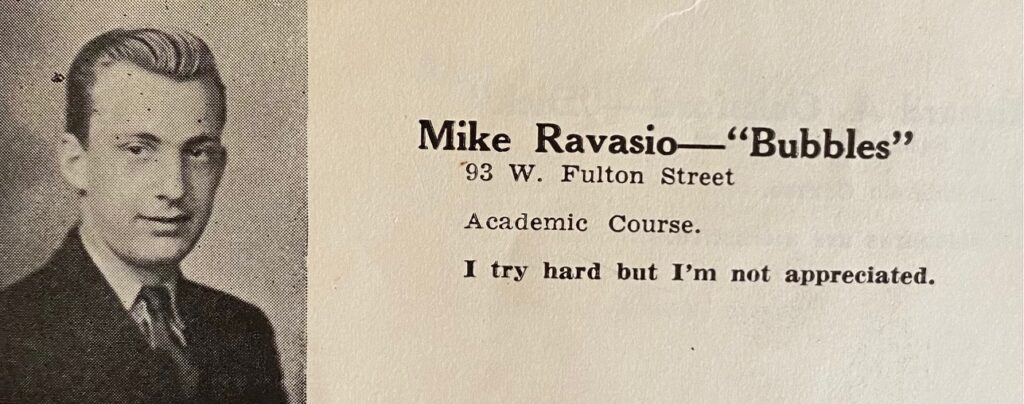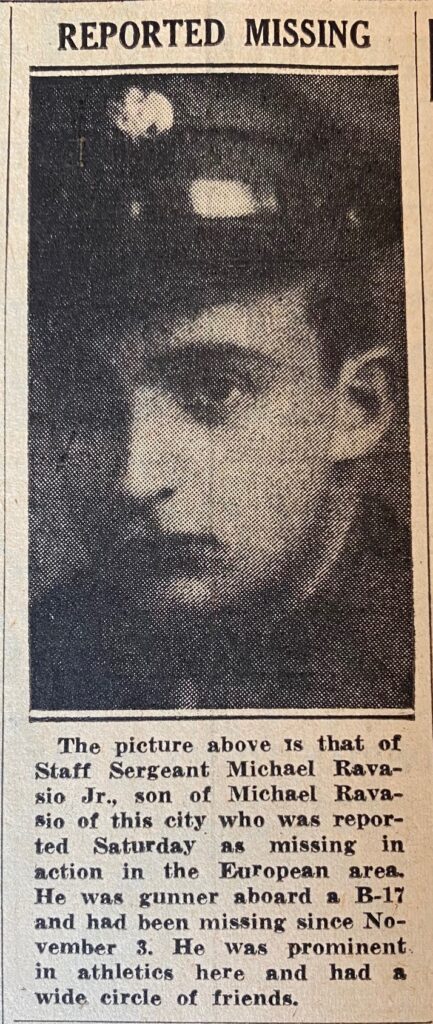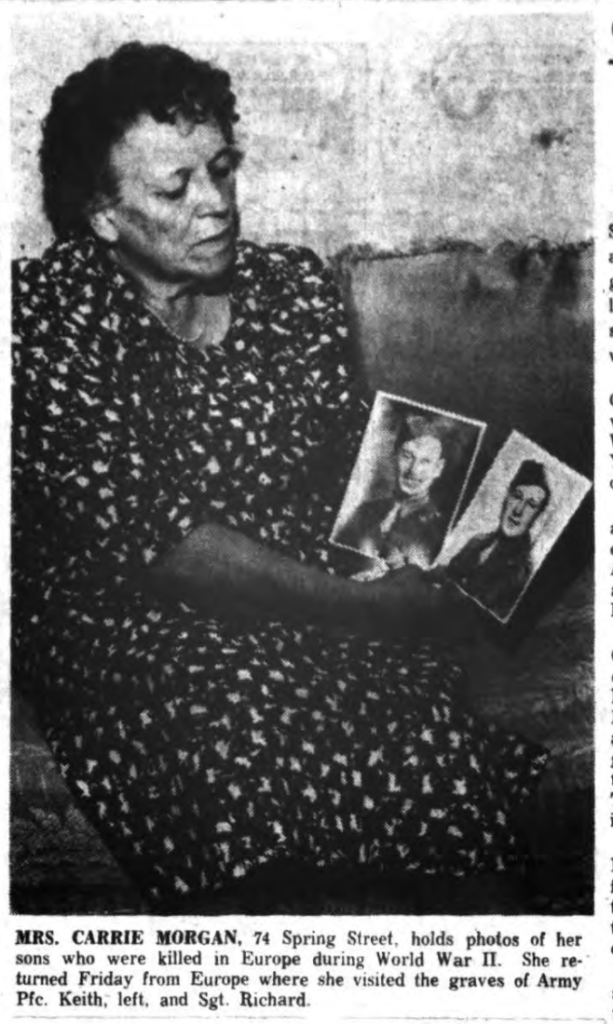Back in mid-October, the FCHS received an email from Teresa Hirsch, a volunteer with the US WWII Cemetery in Margraten, Netherlands. Margraten, the only American military cemetery in the Netherlands, is the final resting place of 8,301 American soldiers who gave their lives during World War II. The cemetery also includes the Tablets of the Missing, containing 1,722 names of men whose bodies were not recovered but were declared killed in action by the US War Department. According to the cemetery’s page on the American Battle Monuments Commission website: “Unique to the cemetery is the connection with the Dutch people. Since 1945 members of the local community have adopted the grave sites of our fallen. They bring flowers to the cemetery and research the life of the service member as a way to honor their sacrifice.” The waiting list to adopt a grave site at Margraten is about 400 people long.
Terry, who is based in Indianapolis, was searching for a photo. Every other year, the cemetery hosts an event during Dutch Memorial Day weekend called “Faces of Margraten.” Photos of the fallen men buried there are placed next to the white cross marking their burial, or their name on the Tablets of the Missing, “bringing visitors face to face with their liberators.” Fields of Honor, an online database that contains the names of about 28,000 American soldiers who have been buried overseas in American Military Cemeteries, includes listings for Margraten. There are five Fulton County boys who are buried there, or whose names are engraved on the Tablets of the Missing. Of these five, only one was missing a photo: S/Sgt Michael A. Ravasio, Jr.
Included in Terry’s email was a clipping from the November 15, 1943 Morning Herald, reporting Sgt. Ravasio’s status as missing. He was 23 years old.
The FCHS is a wonderful repository of many records that are valuable to researchers, genealogists, and those interested in our local history. The museum’s collection of Gloversville and Johnstown High School yearbooks is quite impressive, dating back to the early 20th century all the way up through 2004, with only a few years missing here and there. So, armed with a piece of scrap paper and Sgt. Ravasio’s years of birth and death (1920-1943), we were able to estimate what years he would have been in high school, and what year he might have graduated. There he was in the 1938 graduating class, listed with the nickname “Bubbles” and living at 93 W. Fulton St. in Gloversville. His quote: “I try hard but I’m not appreciated.”

Feeling quite grateful to have been this lucky in researching Sgt. Ravasio, our next step was to take a look at a set of scrapbooks put together by Fulton County Bank employees. These contain newspaper clippings of Gloversville men announced missing or killed in action (and they are mostly chronological and mostly dated). We found the article noting his MIA status in the scrapbooks, but no photo. Unable to find one on the wonderful newspaper website fultonhistory.com (not connected with Fulton County in any way, but it contains thousands of pages of historic newspapers that are free to access), we went to the large bound volumes past issues of newspapers that reside in our small research library. We lugged the massive November-December 1943 volume to a desk, sat down, and opened it at random to begin the search. We didn’t have far to look. There, on the page we had opened to, was Sgt. Michael Ravasio’s photo under the words, “Reported Missing.”

The photos were scanned and sent to Terry. Now Sgt. Ravasio’s images are included in his listing on Fields of Honor and will be placed next to his name at the next Faces of Margraten event.
Following is a brief sketch of the five Fulton County men buried in Margraten Cemetery in the Netherlands. Much of this information was gleaned from the Fields of Honor database, and further research was conducted in local newspapers. Each name is linked to the listing on Fields of Honor, where you can see photos of the men, along with their headstone or name on the wall.
S/Sgt Michael Angelo Ravasio, Jr.
July 31, 1920 – November 3, 1943
Michael was born in Gloversville, the only child of Michael A. Ravasio, Sr. and Mabelle Ravasio. He graduated from Gloversville High School in 1938 and worked at General Electric before enlisting in Utica on August 22, 1942; his draft card indicated his “semiskilled occupations in manufacture of radios and phonographs.”
Ravasio was part of the 368th Bomber Squadron, with the 306th Bomber Group, and rose to the rank of Staff Sergeant. While flying his sixth mission, targeting U-Boat yards in Wilhelmshaven in the northwestern corner of Germany, his B-17 collided midair with another B-17 over the North Sea. All crew members of both planes, twenty men total, were killed.
It was nearly a year before the Ravasios heard anything from the War Department after the initial notice that their son was missing in action. The September 29, 1944 issue of the Morning Herald reported: “Army to Deliver Air Medal of Missing Son to Parents.” Michael Sr., living at the Gloversville Hotel (he and Mabelle were no longer together by 1940), would travel to Rome, NY to receive the medal. It was given for “exceptional meritorius achievement while participating in five separate bomber missions over enemy occupied Continental Europe.” The War Dept. didn’t refer to S/Sgt Ravasio’s status in this communication, and so Michael Sr. was hopeful that his son may still be heard from as a POW. Unfortunately, he was eventually declared dead and his name was later added to the Walls of the Missing at Margraten.
S/Sgt Ravasio’s father, an Italian immigrant and World War I veteran, died on December 7, 1944. Mabelle remarried to Richard Bruce, also a veteran of WWI, the couple living in Mayfield until his death in 1968. Mabelle died on February 20, 1970 at the Fulton County Infirmary. The newspaper indicated that there were no known survivors.
Pvt. Kenneth R. Miller
1924 – March 30, 1945
Information about Pvt. Miller is scant, though he did have several siblings and so it is likely that there are surviving descendants. Miller served in the 53rd Engineer Battalion, 8th Armored Division, C Company. He died on March 30, 1945 of wounds received in action and was awarded the Purple Heart.
On August 7, 1945, the paper reported that his mother, Nellie, received a letter from one of her son’s Army buddies. Included was a publication called “The Buffalo Chips, known as the 8th Armored Division’s own newspaper.” The first platoon of Miller’s company constructed a memorial footbridge over Radbusa River in Stod, Czechoslovakia, in memory of Pvt. Edwin H. Battzes, Pvt. Kenneth R. Miller, and Pfc Ray J. McCormack. They had all been killed by artillery fire in Germany.
Sgt. Richard Morgan
December 22, 1922 – February 23, 1945

Richard Morgan graduated from Gloversville High School in 1939 and worked at the Gloversville Knitting Co. before enlisting in Buffalo on May 8, 1942. Sgt. Morgan served as squad leader for the 115th Infantry Regiment, 3rd Battalion, 29th Infantry Division, M Company. He arrived in England in October 1942 and participated in the invasion of Normandy on D-Day, June 6, 1944. Morgan saw action at Brest and St. Lo; he was wounded June 13, 1944 and was sent to a hospital in England. While he recovered, Morgan was awarded the Purple Heart. He forwarded it home to his parents.
Morgan returned to active duty within a month. In a letter to his family in Gloversville, Morgan mentioned that he had passed through Aachen, Germany after it had been captured that October. Other letters mentioned various locations in Germany that he traveled through. Early in October 1944, he was promoted on the battlefield to Sergeant.
While crossing the Ruhr River with his men in a movement against the town of Broich, Sgt. Morgan stepped on a mine and was struck with shrapnel. He died of his wounds on February 23, 1945.

Richard wasn’t the only Morgan son to lose his life in WWII. His brother, Pfc Keith Morgan, was also killed in action on April 8, 1945 and is buried at the Lorraine Cemetery in St. Avoid, France. Curious as to why the two brothers chose to be buried overseas, rather than at home, I turned to some local newspapers. On September 25, 1962, the Leader-Herald published the article, “Gold Star Mother Visits Sons’ Graves in Europe.” Carrie Morgan, living at 74 Spring Street, “explained that her sons had told her that the only way they would come back to the US is alive. ‘That’s why I had them buried overseas and I have no regrets,’ she said.” It wasn’t until later that she learned the two brothers could have been buried together in Margraten, which is why Keith was in France. The trip was sponsored by the group Gold Star Mothers; all Carrie needed to pay was her airfare.
Besides Keith and Richard, Carrie and her husband Cady also had four daughters: Dorothy Carr, Bernice Eschler, Gladys Falter, and Janice Glover, as well as 11 grandchildren and 10 great-grandchildren. Keith left behind a widow, Frances Hollenbeck, and daughter Phyllis Edwards.
Pfc. Paul H. Rowley (“Packey”)
July 7, 1909 – April 2, 1945
The oldest of the five men buried in Margraten, Rowley was born on July 7, 1909 in Troy, NY. Known as Packey among his friends, he worked as a bartender and had a relatively good run as an amateur boxer in local fights. In October 1928, he signed on with manager William Jones from New York City, who believed “that Gloversville has a champion in the making.” Packey won 24 successive amateur bouts and one professional 4-round fight before making his formal debut into the professional class when he signed on with Jones.
Rowley enlisted in Utica on January 22, 1944 and was assigned to the 36th Armored Infantry Regiment, 1st Battalion, 3rd Armored Division, A Company. He arrived in England only seven months after enlisting, and was in active combat for eight months. Rowely was wounded three times: January 12th, February 2nd, and April, 1945. He died of his wounds in the Paderborn area of Germany on April 22, 1945. Survived by Rowley was his wife Alma, and three sons, James, Edward, and William.
Lt. Douglas H. Baker
1921 – November 29, 1943
Douglas Baker was the only son of Michael and Goldie Baker; he had two sisters, Dorothy and Muriel. Lt. Baker was a Bombardier with the 8th Air Force, 548th Bomber Squadron, 385th Bomber Group. In October 1943, he was mentioned in news stories “as having shot down a Messerschmidt 109 over Germany. At that time he was a member of the crew known as ‘Weider’s Wildcats.’”
By November he was flying in a B-17, nicknamed “Who Dat Ding Bat.” While flying toward Bremen, Germany on November 29, 1943, the pilot stated that he had only a 30-minute gas supply left and dropped out of formation somewhere over the Zuiderzee, planning to try to reach England to refuel. The plane was last seen going down through the clouds near Texel Island. The plane was apparently shot down over the English Channel and the entire crew drowned. Lt. Baker’s name is listed on the Wall of the Missing at Margraten.
His family was heavily involved with the Bleecker St. Church of Christ, and on June 23, 1947, the church installed a new organ and dedicated it to three of the congregation who lost their lives in the war: Fenton Brown, David Cominole, and Douglas Baker.
Terry sent along the link to short video from the 2018 Faces of Margraten Tribute, which you can watch below. She wrote: “It is rather a wonderful tribute. And in this day and age of photos of everything everywhere, it seems to resonate with the younger generations as well.”
Many thanks to Terry and all of the wonderful volunteers, researchers, and Dutch families who work so hard to ensure that these brave men, who gave the ultimate sacrifice, continue to be remembered and honored throughout the generations.
